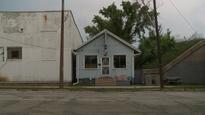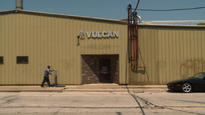JAMES BENNING - ONE WAY BOOGIE WOOGIE 2012
EXHIBITION
Opening Night 29.09.2012 // 18:00-21:00
James Benning (1942) is one of the pioneers of independent film in the USA. His rigorous structures and tightly composed images betray his mathematical background, whereas the often autobiographical subjects reflect his working-class roots and outspoken political activism. Benning elaborates on elements from structural film, but at the same time he is perceived as a protagonist of the new narrative movement during the 1980s. After nearly four decades of 16mm work, digital high-definition has allowed him to become even more autonomous than before, while also increasing his productivity: his recent HD films confirm his classical themes as in Ruhr (2009) or small roads (2011), but they also give way to new aesthetics like the portraiture in Twenty Cigarettes (2011) or the remake in Faces (2011).
For his first solo exhibition in Belgium, James Benning presents a six channels video installation which is the third version of his 1977 seminal film: One Way Boogie Woogie 2012 consists of eighteen long static shots with location recordings plus a Leonard Cohen song. If Mondrian’s abstract painting Broadway Boogie Woogie (1942-43) was a celebration of Manhattan’s dynamism, Benning offers a portrait of another America.
In 1977 he filmed 60 locations - each for 60 seconds - in Milwaukee’s industrial valley. His experiment documented the traces of decay of the metropolitan landscape and offered a meditation on destruction and progress. Then Benning remade a new film with the same 60 camera positions, along with the same Bolex 16mm camera and Nagra tape recorder: the result was called Twenty Seven Years Later (2004) and it is a genuine exploration of how memory functions and how much the entire area has been affected by industrialism.
Last year Benning returned for the third time, but he only found ten locations that remained similar to 1977, so he integrated eight new places which are reminiscent of the originals. This time-travel confrontation represents Milwaukee as a physical place, revealing the landscape in beautiful detail, and commenting on the process of industrial, political and economic change in urban America over a thirty-four year period. (Andrea Cinel)
James Benning (1942) is one of the pioneers of independent film in the USA. His rigorous structures and tightly composed images betray his mathematical background, whereas the often autobiographical subjects reflect his working-class roots and outspoken political activism. Benning elaborates on elements from structural film, but at the same time he is perceived as a protagonist of the new narrative movement during the 1980s. After nearly four decades of 16mm work, digital high-definition has allowed him to become even more autonomous than before, while also increasing his productivity: his recent HD films confirm his classical themes as in Ruhr (2009) or small roads (2011), but they also give way to new aesthetics like the portraiture in Twenty Cigarettes (2011) or the remake in Faces (2011).
For his first solo exhibition in Belgium, James Benning presents a six channels video installation which is the third version of his 1977 seminal film: One Way Boogie Woogie 2012 consists of eighteen long static shots with location recordings plus a Leonard Cohen song. If Mondrian’s abstract painting Broadway Boogie Woogie (1942-43) was a celebration of Manhattan’s dynamism, Benning offers a portrait of another America.
In 1977 he filmed 60 locations - each for 60 seconds - in Milwaukee’s industrial valley. His experiment documented the traces of decay of the metropolitan landscape and offered a meditation on destruction and progress. Then Benning remade a new film with the same 60 camera positions, along with the same Bolex 16mm camera and Nagra tape recorder: the result was called Twenty Seven Years Later (2004) and it is a genuine exploration of how memory functions and how much the entire area has been affected by industrialism.
Last year Benning returned for the third time, but he only found ten locations that remained similar to 1977, so he integrated eight new places which are reminiscent of the originals. This time-travel confrontation represents Milwaukee as a physical place, revealing the landscape in beautiful detail, and commenting on the process of industrial, political and economic change in urban America over a thirty-four year period. (Andrea Cinel)
Related events




-
Sun 30.9.2012
- Sun 16.12.2012
-
Practical info
Location:
Argos
Werfstraat 13 rue du Chantier
1000 Brussels
info@argosarts.org
+32 2 229 00 03
Opening hours:
Wednesday to Sunday, 11:00 to 18:00
Entrance Fee:
5 / 3 euros - Artists